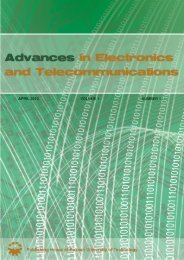november 2010 volume 1 number 2 - Advances in Electronics and ...
november 2010 volume 1 number 2 - Advances in Electronics and ...
november 2010 volume 1 number 2 - Advances in Electronics and ...
You also want an ePaper? Increase the reach of your titles
YUMPU automatically turns print PDFs into web optimized ePapers that Google loves.
LANGE AND KASZNIA: APPLICATION OF VERNIER INTERPOLATION FOR DIGITAL TIME ERROR MEASUREMENT 49<br />
Fig. 2. Tim<strong>in</strong>g diagram of vernier with 2 generators.<br />
TABLE I<br />
RELATION BETWEEB COINCIDENCE TIME AND MEASUREMENT<br />
RESOLUTION<br />
Resolution τ [ps] 1 5 10 50 100 500<br />
Co<strong>in</strong>cidence time tk [µs] 400 80 40 8 4 0,8<br />
<strong>in</strong>tuitive dependence:<br />
tk = T1T2<br />
≈<br />
T1 − T2<br />
1<br />
f 2τ + ∆t (8)<br />
where tk is the time of achiev<strong>in</strong>g co<strong>in</strong>cidence, f is an average<br />
frequency of generators, ∆t is the duration of exam<strong>in</strong>ed time<br />
<strong>in</strong>terval, <strong>and</strong> τ is the measurement resolution.<br />
The dependence express<strong>in</strong>g this relation – without tak<strong>in</strong>g<br />
<strong>in</strong>to account the impact of ∆t as well as for an assumed f<br />
average value of frequency of the vernier generators 50 MHz<br />
<strong>and</strong> a few possible sett<strong>in</strong>gs of resolution – is presented <strong>in</strong><br />
TABLE I. From the relations it results that <strong>in</strong> order to achieve<br />
a low resolution τ of the measurement of time <strong>in</strong>terval ∆t, the<br />
vernier circuit requires a process<strong>in</strong>g time that can significantly<br />
fulfill the <strong>in</strong>equality:<br />
tk > ∆t (9)<br />
Conclusionof<strong>in</strong>equality(9)limitsthemeasurementdynamics,<br />
which implies that each considered <strong>in</strong>terval must appear at the<br />
<strong>in</strong>put of the vernier circuit <strong>in</strong> time <strong>in</strong>terval greater than time<br />
tk [4].<br />
Technological limitations are result of the potential of implement<strong>in</strong>g<br />
the quick-start generators. As already mentioned,<br />
it is impossible to <strong>in</strong>troduce <strong>in</strong>to a generator a resonance<br />
system with large quality factor which will ensure a frequency<br />
<strong>in</strong>stability sufficient dur<strong>in</strong>g the measurement.<br />
In this situation a possible solution is e.g. to use a generator<br />
with delay l<strong>in</strong>e, <strong>in</strong> which the vibration period of this generator<br />
will be a function of delay time. Unfortunately, the performance<br />
of generator of that type is not stable enough <strong>and</strong> its<br />
output frequency depends, among others, on: temperature, the<br />
repeatability of applied circuits, supply voltage or the stability<br />
of the delay l<strong>in</strong>e itself. Summariz<strong>in</strong>g, technological problems<br />
can be, to some degree,reducedto “<strong>in</strong>fect<strong>in</strong>g”adigital system<br />
with a quasianalog unit with all consequences of such move.<br />
Fig. 3. Schematic diagram of generator.<br />
IV. DESCRIPTION OF CIRCUIT CONSTRUCTION<br />
In the experiment carried out the real signal from the<br />
real phase detector was replaced with a precise generator<br />
of time <strong>in</strong>terval. It is unimportant from the functional po<strong>in</strong>t<br />
of view; such replacement, however, makes it easier to set<br />
different time <strong>in</strong>tervals, which was proved to be suitable <strong>in</strong><br />
the analysis of errors of manufactured vernier circuits. The<br />
researchcarriedoutontheverniercircuitconcernsthesolution<br />
with 2 generators. The most important circuit <strong>in</strong> this case is<br />
the quick-start generator. The authors decided to <strong>in</strong>troduce<br />
programmable delay circuits to the generator. Thanks to the<br />
controlofdelayvalues,attemptsto optimizethissolutionwere<br />
possible. A schematic diagram of the generator is given <strong>in</strong><br />
Fig. 4 [4].<br />
The generator consists of two flip-flops 74AC74, delay<br />
l<strong>in</strong>e Dallas DS1020-25 [5], <strong>and</strong> gates 74AC00, 74AC86 <strong>and</strong><br />
74AC04.AXORgateisfedwiththeexam<strong>in</strong>edsignal.Because<br />
there are two such generators <strong>in</strong> the vernier circuit, the task<br />
of the gate is to compensate delays related to the start of the<br />
generators, as well as to determ<strong>in</strong>e whether a generator should<br />
be triggered by the lead<strong>in</strong>g (ris<strong>in</strong>g) or trail<strong>in</strong>g (fall<strong>in</strong>g) edge of<br />
the <strong>in</strong>put signal. The operation of the circuit utilizes the idea<br />
of positive feedback with the delay l<strong>in</strong>e.<br />
The construction of the l<strong>in</strong>e requires that the pulse duration<br />
to be delayed is longer than the delay time. This is the reason<br />
for <strong>in</strong>troduc<strong>in</strong>g a negator <strong>in</strong>to the reset circuit of flip-flop U1.<br />
The digital l<strong>in</strong>e DS1020-25 [4] applied <strong>in</strong> the circuit has the<br />
delay programmed with 8-bit word with step 150 ps. Only<br />
4 lower bits are used, however, because a delay longer than<br />
12,4 ns is not required. This value results from summ<strong>in</strong>g up<br />
16x150 ps <strong>and</strong> 10 ns. 10 ns is the m<strong>in</strong>imum value of the delay<br />
that can be achieved <strong>in</strong> the digital l<strong>in</strong>e DS1020-15.<br />
Theperiodofsuch generatoris a sum ofdelaysofparticular<br />
elements form<strong>in</strong>g the generator. After the digital word is<br />
provided at the output, its edge is propagated through flipflop<br />
U1A with time τU1. Then, the edge is delayed by the<br />
digital delay l<strong>in</strong>e DS1020 with controllable delay τDS, passes<br />
aga<strong>in</strong> onto the flip-flop – this time U2A with delay τU2 – <strong>and</strong><br />
is sent at the generator output. To pulses generated after the<br />
start pulse we should add also the propagation time τNAND<br />
from the output to gate NAND to flip-flop U1A. Therefore,<br />
the period of generated measurement signal equals:<br />
T = τU1 + τU2 + τNAND + τDS<br />
(10)<br />
In formula (10) the first three factors are almost constant.







